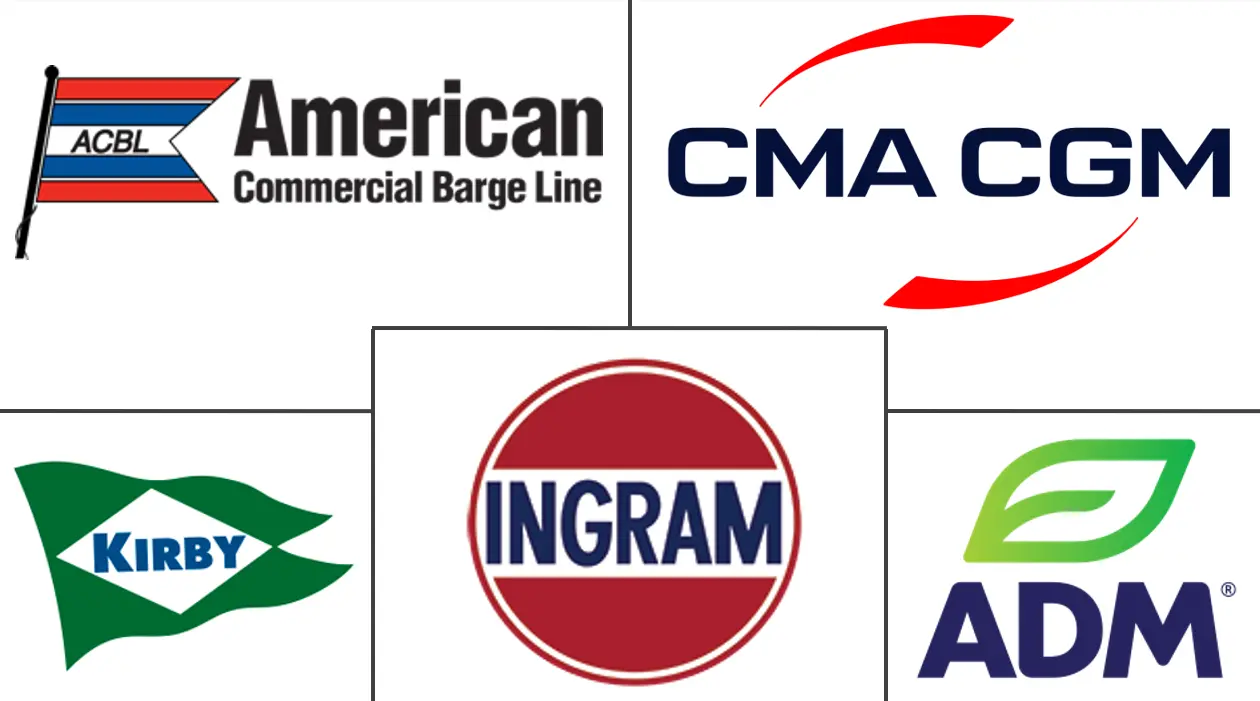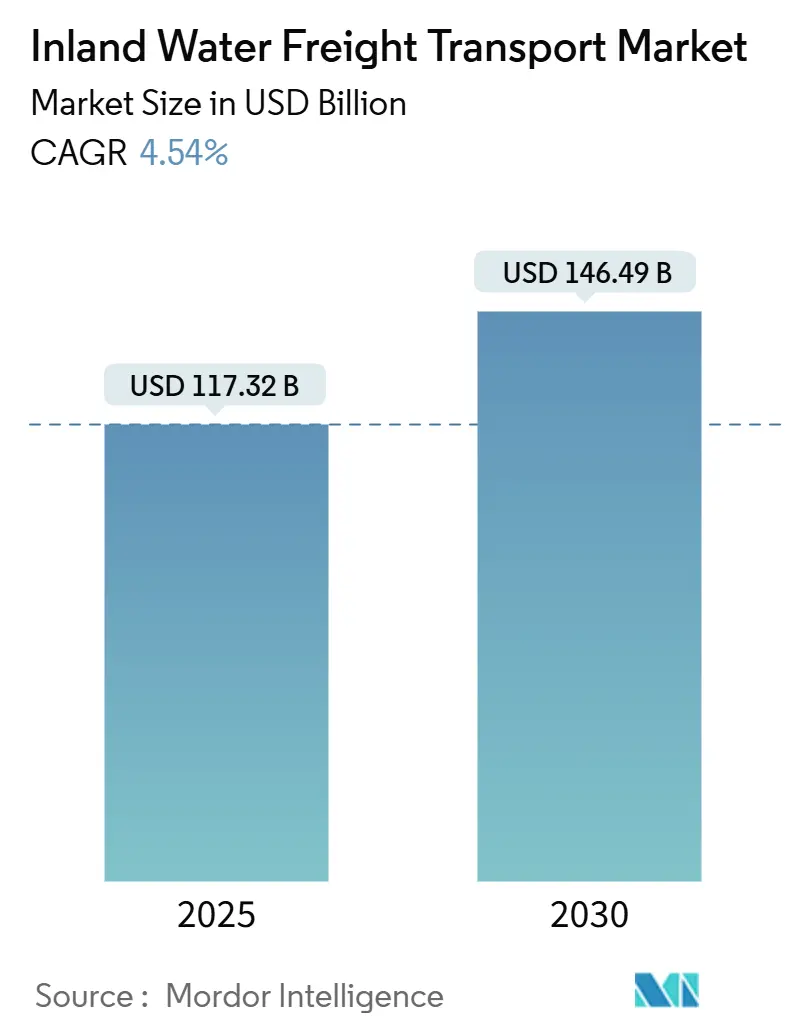
Inland Water Freight Transport Market Analysis by Mordor Intelligence
The Inland Water Freight Transport Market size is estimated at USD 117.32 billion in 2025, and is expected to reach USD 146.49 billion by 2030, at a CAGR of 4.54% during the forecast period (2025-2030).
Governments are accelerating modal-shift policies to curtail road congestion and emissions, and shippers recognize that barge logistics can cut end-to-end freight bills by 14-18% while saving more than 50% in fuel consumption relative to trucks. Europe anchors demand thanks to its 41,000-kilometer network and mature policy support, yet Asia-Pacific’s infrastructure boom is positioning the region as the next growth engine of the inland water freight transport market[1]Tom Cassauwers, “Researchers Use Blockchain and AI to Reclaim Europe’s Inland Waterways,” phys.org. Liquid bulk leads current volumes as refineries and chemical producers rely on barges for safe, large-lot movement, while dry bulk is gaining momentum on the back of infrastructure build-outs in emerging economies. Digital transformation, ranging from River Information Services 4.0 to AI-enabled voyage optimization, is reshaping operational efficiency and creating fresh competitive advantages.
Key Report Takeaways
- By transportation type, liquid bulk led with 37% of the inland water freight transport market share in 2024; dry bulk is forecast to expand at a 4.8% CAGR to 2030.
- By end-user industry, petroleum and chemicals commanded 31% share of the inland water freight transport market size in 2024, while consumer goods and retail is projected to grow at a 4.1% CAGR through 2030.
- By geography, Europe captured 45% revenue share in 2024; Asia-Pacific is advancing at a 5.1% CAGR over 2025-2030.
Global Inland Water Freight Transport Market Trends and Insights
Drivers Impact Analysis
| Driver | (≈) % Impact on CAGR Forecast | Geographic Relevance | Impact Timeline |
|---|---|---|---|
| Cost-efficiency versus road & rail | +1.2% | Europe & North America | Medium term (2-4 years) |
| Growing bulk-commodity demand & industrial output | +0.9% | Asia-Pacific, spill-over to MEA & South America | Long term (≥ 4 years) |
| Urban-logistics demand for micro-barge solutions | +0.6% | Europe & North America cities | Short term (≤ 2 years) |
| EU modal-shift incentives | +0.8% | Europe, demonstration globally | Medium term (2-4 years) |
| RIS 4.0 & AI voyage optimization | +0.5% | Europe & North America, expanding to APAC | Long term (≥ 4 years) |
| Decarbonization push for LNG/e-fuel fleets | +0.4% | Global, led by Europe | Long term (≥ 4 years) |
| Source: Mordor Intelligence | |||
Cost-efficiency versus road & rail
Barges can move the same tonnage using nearly one-fifth of the fuel consumed by trucks, which translates into sharp reductions in carbon-pricing exposure and operating costs[2]World Bank, “Moving from Roads to Rivers,” worldbank.org. As diesel prices creep upward and governments expand emissions-trading schemes, the economic gap widening in favor of water transport draws more bulk shippers into the inland water freight transport market. High-volume routes such as Rotterdam–Duisburg demonstrate that carbon-adjusted door-to-door rates undercut comparable road services, even after factoring in trans-shipment charges. The resulting uptick in modal shift is visible in rising barge call frequencies at Rhine-adjacent terminals. These dynamics will continue to add momentum to the inland water freight transport market through 2028.
Growing bulk-commodity demand & industrial output
Steel, cement, and energy-transition minerals underpin sustained growth in emerging economies, and barge fleets offer the most cost-effective way to handle these heavy, low-value cargoes[3]Department of Industry, “Resources and Energy Quarterly 2024,” industry.gov.au. China’s 70-billion-yuan Pinglu Canal and India’s activation of 111 national waterways unlock fresh corridors that funnel more bulk volumes toward inland vessels. Even declining coal demand in Europe is offset by burgeoning flows of nickel, lithium, and bauxite used in battery supply chains. As a result, the inland water freight transport market is absorbing incremental tonnage that would otherwise overwhelm road and rail networks. Long-haul intercontinental commodity patterns, such as Australian iron ore feeding Asian steel mills, likewise create sustained back-haul opportunities for barge operators.
Urban-logistics demand for micro-barge solutions
Congested city streets and strict emission zones are encouraging municipalities to test micro-barge pilots for last-mile deliveries. Projects in Amsterdam, Paris, and Strasbourg collectively suggest that up to half of inner-city parcel movements could shift from trucks to water over the next decade. Electric or hydrogen-powered mini-barges unload freight onto cargo bikes at riverside micro-hubs, trimming noise and particulate pollution while freeing road capacity. Early adopters report delivery-time parity with road couriers during peak traffic hours. Although quay accessibility and scheduling remain hurdles, replicable design templates and favorable municipal incentives are accelerating deployment. These trends inject additional volume diversity into the inland water freight transport market.
EU modal-shift incentives
The Connecting Europe Facility dedicates substantial capital toward waterway modernization and intermodal links, reinforcing Brussels’ goal of lifting inland volumes by 25% by 2030[4]CINEA, “Transport Infrastructure,” cinea.ec.europa.eu. Complementary schemes such as Mode Shift Revenue Support in the United Kingdom reimburse shippers for choosing barges over trucks, while upcoming carbon-border adjustments further tip cost equations in favor of low-emission modes. Collectively, these programs lower the investment hurdle for fleet renewal and terminal upgrades, enhancing the competitiveness of the inland water freight transport market. As other regions adopt similar frameworks, demonstration effects are expected to ripple into North American and Asian policy circles.
Restraints Impact Analysis
| Restraint | (≈) % Impact on CAGR Forecast | Geographic Relevance | Impact Timeline |
|---|---|---|---|
| Ageing lock & dam infrastructure | −0.7% | North America & Europe | Short term (≤ 2 years) |
| Climate-driven low-water volatility | −0.5% | Global hot spots | Medium term (2-4 years) |
| Empty-container imbalance & rate volatility | −0.4% | Asia–Europe lanes | Medium term (2-4 years) |
| Skilled-crew shortages | −0.3% | North America & Europe | Long term (≥ 4 years) |
| Source: Mordor Intelligence | |||
Ageing lock & dam infrastructure
Nearly half of U.S. lock chambers are older than their 50-year design life, and the Poe Lock remains a single-point failure that could disrupt USD 500 billion in annual freight flows if shuttered. European canals face similar stress, prompting intensive maintenance programs in the Netherlands and Germany. Funding lags, however, slow replacement timetables, constraining throughput, and raising downtime risks. Predictive monitoring tools extend structure lifespans but cannot fully offset the capacity cap imposed by antiquated infrastructure. Consequently, infrastructure fragility tempers the growth outlook of the inland water freight transport market in the near term.
Climate-driven low-water volatility
Severe droughts on the Rhine, Danube, and Mississippi have periodically cut load factors by up to 50%, forcing costly light-loading or modal shifts to rail. Projections suggest the shipping sector could forfeit USD 10 billion annually by 2050 if hydrological variability remains unmitigated. Vessel redesigns for shallow draughts and dynamic routing based on satellite-derived water-level forecasts provide partial relief. Long-term resilience, however, hinges on large-scale dredging, river engineering, and water-storage investments, the pace of which will influence the inland water freight transport market trajectory.
Segment Analysis
By Type of Transportation: Liquid Bulk Leads Market Share
Liquid bulk captured 37% of the inland water freight transport market share in 2024, underpinned by specialized tank-barge fleets that satisfy stringent safety and environmental regulations. Petroleum products, chemicals, and biofuels dominate the cargo mix, and long-term contracts guarantee stable barge utilization. This segment benefits from infrastructure co-location, as refineries and petrochemical complexes cluster along navigable rivers, reducing pipeline dependence and trucking costs. Innovations such as double-hulled barges and vapor-recovery systems enhance compliance with emission norms, reinforcing customer preference for waterborne solutions.
Dry bulk is projected to post a 4.8% CAGR (2025-2030), the quickest within the inland water freight transport market, as developing economies ramp up demand for cement, clinker, and agricultural commodities. Fleet operators are enlarging hopper capacities and adopting self-unloading systems to shave port-stay times. Nevertheless, variable river depths necessitate adaptive loading strategies, occasionally eroding voyage economics. Containerized and roll-on/roll-off segments remain niche but are steadily expanding with e-commerce growth and regional automotive trade, respectively. Overall, multimodal integration and digital scheduling tools are set to unlock latent capacity across all transportation types.
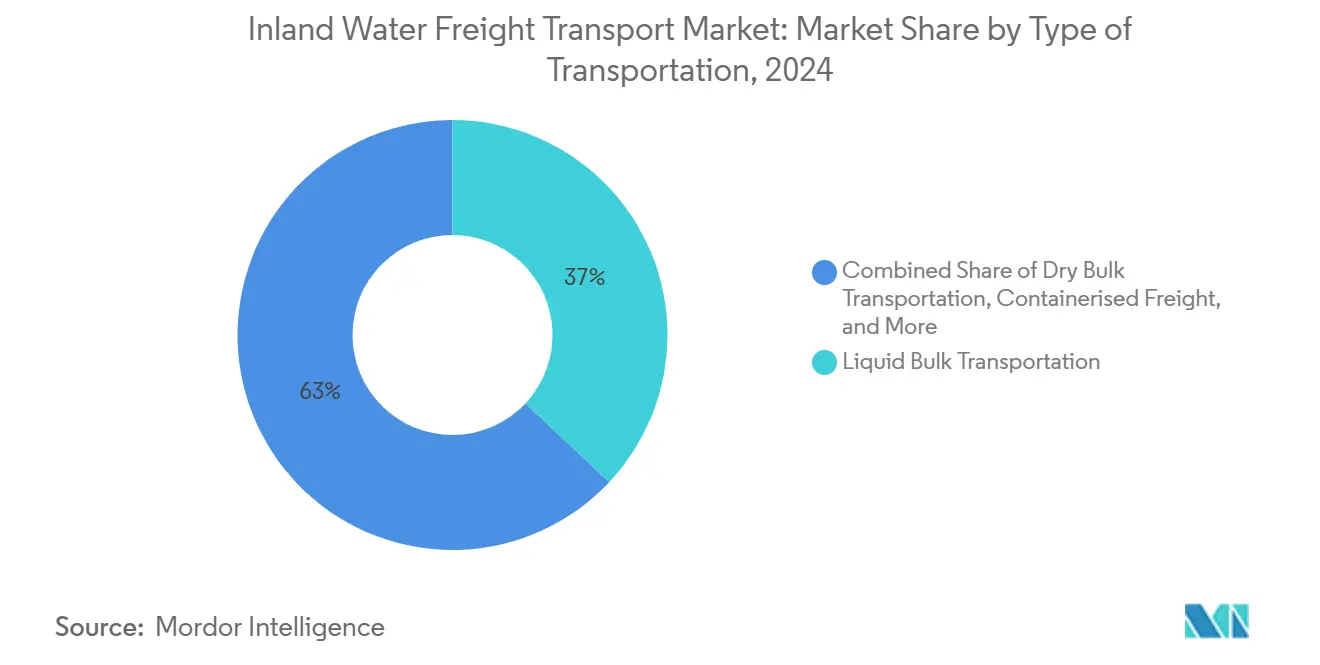
Note: Segment shares of all individual segments available upon report purchase
By End-User Industry: Chemicals Drive Current Demand
The petroleum and chemicals cluster accounted for 31% of the inland water freight transport market size in 2024, reflecting the overwhelming volume of hazardous liquids requiring water-based conveyance. Stringent containment and spill-response standards drive shippers toward barge solutions, where larger parcel sizes minimize per-ton costs. The concentration of refineries along the Gulf Coast in North America and the Rhine-Ruhr in Europe underscores the strategic role of inland waterways in feedstock logistics.
Consumer goods and retail, although smaller, is advancing at a 4.1% CAGR (2025-2030) on the back of micro-barge initiatives that support e-commerce fulfillment in dense city centers. Retailers value predictable delivery windows and carbon-footprint reductions attainable through water routes. Agriculture and food continue to rely on barges for grain exports, especially during peak harvest seasons when rail congestion escalates. Mining and metallurgy maintain baseline demand for iron ore and coal movement, while the energy transition is nudging barge traffic toward biomass and renewable fuels. Collectively, end-user diversification shields the inland water freight transport market from cyclical swings in any single sector.
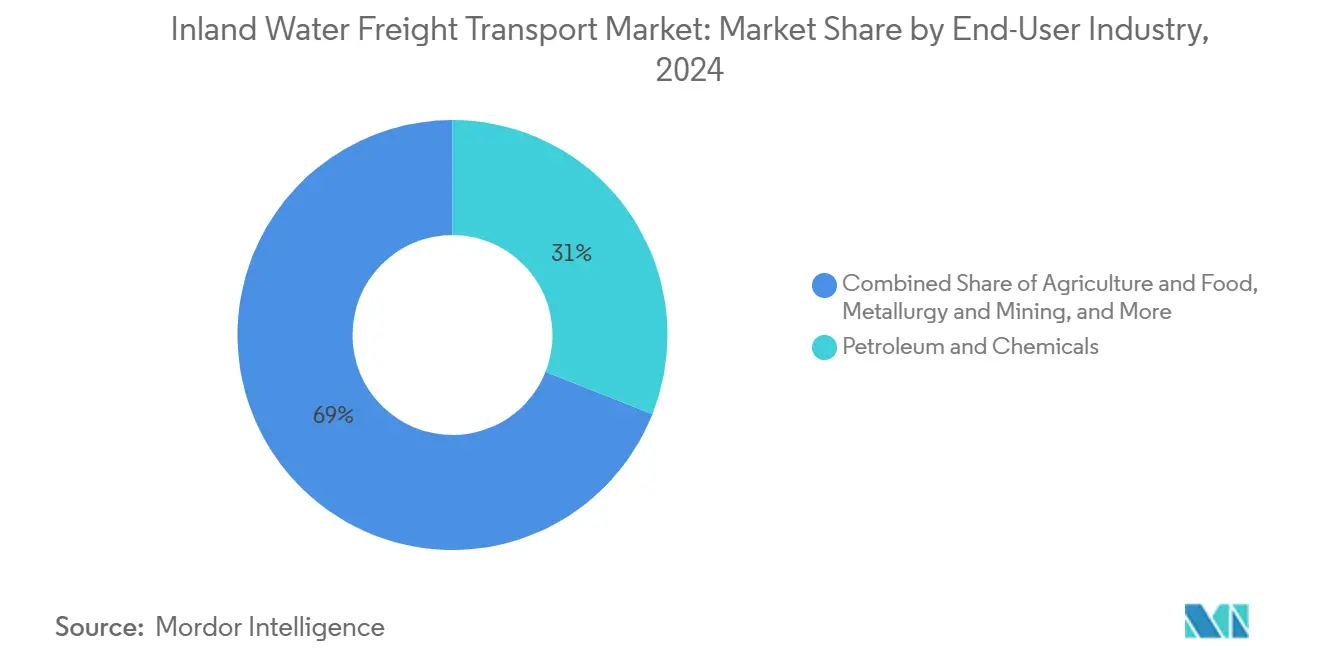
Note: Segment shares of all individual segments available upon report purchase
Geography Analysis
Europe retained 45% of global revenues in 2024, moving over 150 billion tonne-kilometers across its 25 inland navigation Member States. The Rhine-Alpine corridor remains the backbone of continental trade, yet low-water events in the past few years exposed its vulnerability. European Commission programs such as NAIADES III and TEN-T modernization funnel substantial grants toward lock upgrades and alternative-fuel vessels to safeguard reliability and decarbonization targets. Market participants, therefore, expect steady but moderate expansion of the inland water freight transport market in Europe through 2030.
Asia-Pacific is the fastest-growing arena, clocking a 5.1% CAGR (2025-2030) on the strength of China’s CNY 545 billion (USD 74.6 billion) canal projects and India’s rollout of 111 national waterways. The Inland Waterways Authority of India has already reported double-digit traffic gains following dredging and terminal investments under Maritime Vision 2030. Vietnam’s Mekong Delta, Indonesia’s archipelagic corridors, and the Philippines’ inter-island trades are also attracting donor funding from the Asian Development Bank, reflecting mounting confidence in water transport solutions.
North America maintains sizeable volumes across the Mississippi River and Great Lakes systems, yet reliability hinges on overhauling ageing locks and dams that date back to the 1930s. Federal funding under the Infrastructure Investment and Jobs Act has earmarked billions for inland upgrades, but construction timelines extend beyond 2028, leaving near-term capacity exposed. Latin American and African markets remain nascent but exhibit high upside, particularly in Brazil’s Madeira and Tapajós rivers and Nigeria’s Niger corridor, where agricultural exporters seek cheaper paths to port. Collectively, geographic diversification insulates the inland water freight transport market from regional shocks.
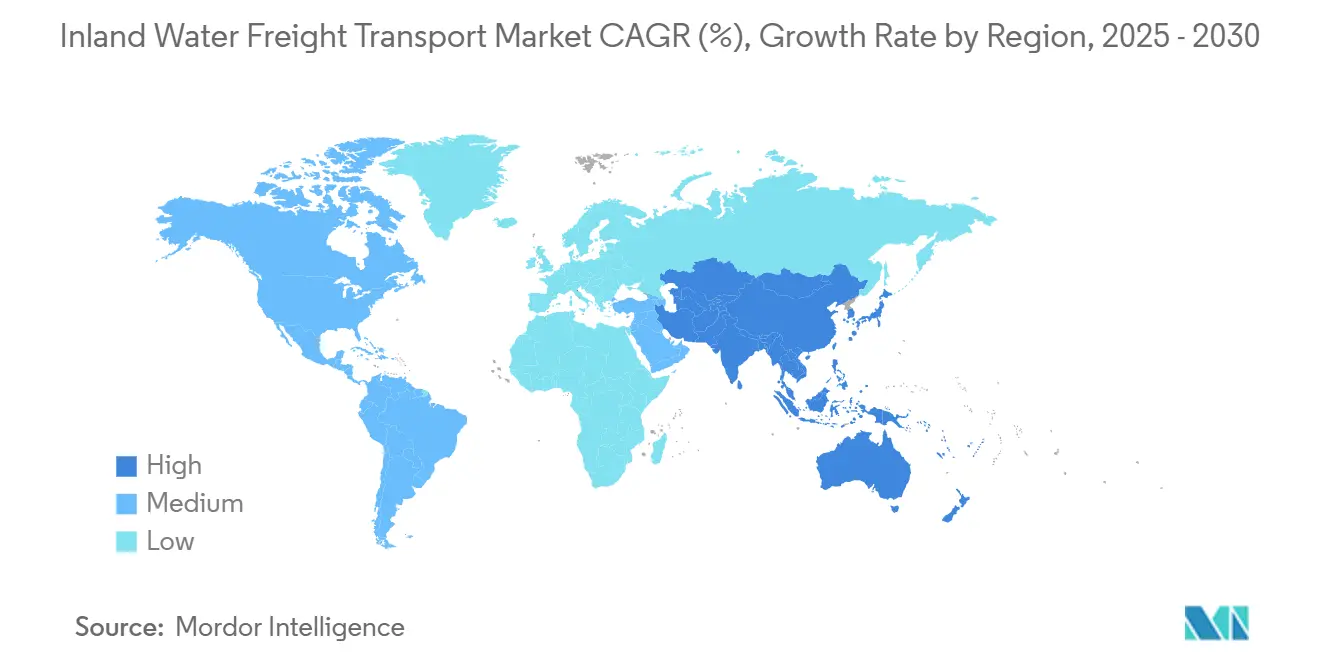
Competitive Landscape
The inland water freight transport market is moderately fragmented. American Commercial Barge Line’s 2024 reorganization consolidated dispatch and maintenance into a new barge-pooling unit aimed at pushing fleet utilization above 90%. Kirby Corporation, holding the largest U.S. tank-barge fleet, is leveraging AI scheduling to trim voyage idle time and has earmarked USD 150 million for alternative-fuel retrofits that cut carbon intensity by 25% before 2030.
European operators such as Future Proof Shipping and Rhenus Logistics are pivoting toward hydrogen and battery-electric propulsion to secure green-corridor contracts, notably on the Rotterdam–Duisburg axis. CMA CGM’s Vietnam pilot underscores how blue-water carriers are extending brand reach inland, bundling ocean and barge services under integrated logistics offerings. Strategic moves in mergers and acquisitions are likely, as operators seek fleet scale, digital capabilities, and geographic coverage to win high-volume, multi-year tenders. Supply-side consolidation and technology adoption, therefore, constitute dual pathways to competitive advantage within the inland water freight transport market.
Advancements in digital twins, predictive maintenance, and cargo-tracking APIs are becoming table stakes rather than differentiators. Operators unable to finance fleet renewal or comply with emergent emission mandates risk relegation to low-margin spot markets. Conversely, companies that align vessel portfolios, fuel strategies, and data capabilities with rapidly tightening ESG expectations stand to capture premium contract rates. The resulting shake-out will gradually raise market entry barriers, nudging the inland water freight transport industry toward higher capital intensity and professionalism.
Inland Water Freight Transport Industry Leaders
American Commercial Barge Line
Ingram Barge
Kirby Inland Marine
American River Transportation
CMA CGM Group
- *Disclaimer: Major Players sorted in no particular order
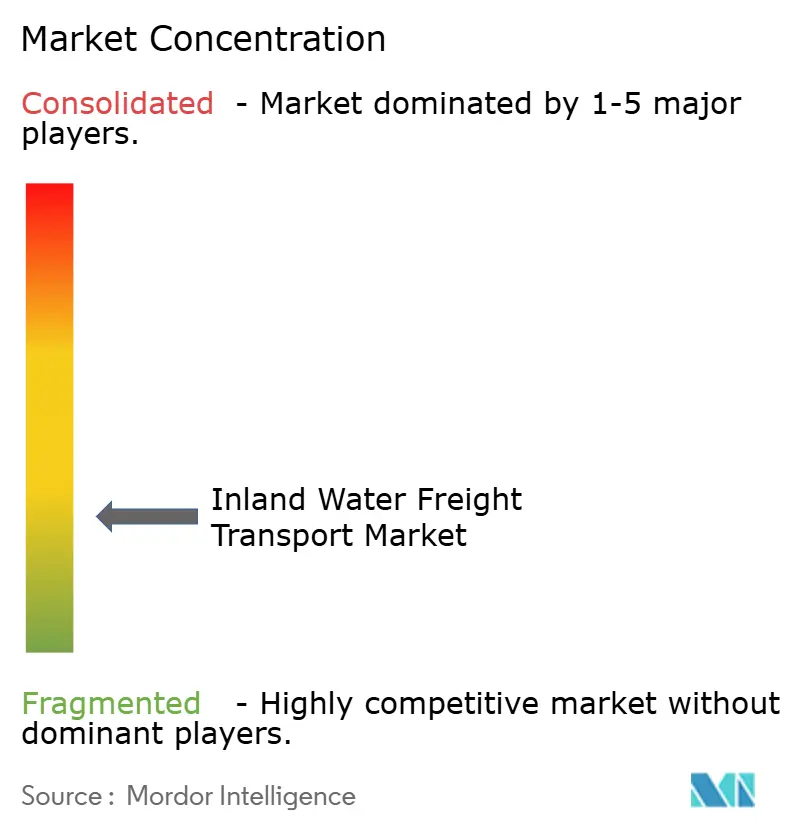


Recent Industry Developments
- May 2025: Tennessee partnered with Ingram Marine Group to build a USD 30 million multimodal river port near Nashville to alleviate freight bottlenecks and spur local job creation.
- March 2025: Mitsui O.S.K. Lines deployed the world’s first ammonia-fueled Capesize bulkers and chemical tankers, signaling a breakthrough in zero-carbon propulsion.
- March 2025: CMA CGM ordered the first electric inland container barge in Vietnam, slated to carry Nike products along a 180-kilometer Saigon corridor from 2026.
- January 2024: Maersk and Hapag-Lloyd formed Gemini Cooperation, combining 290 vessels to achieve 90% schedule reliability across seven trade lanes.
Global Inland Water Freight Transport Market Report Scope
Any transportation of goods made with inland waterways vessels and completed entirely or in part on navigable interior waterways is referred to as inland water freight transport. Inland waterways transport refers to the transportation of goods made entirely on navigable inland rivers employing seagoing vessels.
A complete background analysis of the inland water freight transport market, including the assessment of the economy and contribution of sectors in the economy, market overview, market size estimation for key segments, and emerging trends in the market segments, market dynamics, and geographical trends, and the COVID-19 impact, is covered in the report.
The inland water freight transport market is segmented by type of transportation (liquid bulk transportation and dry bulk transportation), vessel type (cargo ships, container ships, tankers, and other vessel types), and geography (North America, Europe, Asia-pacific, Latin America, and Middle East and Africa). The market sizes and forecasts are provided in terms of value (USD) for all the above segments.
| Liquid Bulk Transportation | |
| Dry Bulk Transportation | |
| Containerised Freight | Dry |
| Reefer | |
| Roll-On / Roll-Off Cargo |
| Agriculture & Food |
| Metallurgy & Mining |
| Petroleum & Chemicals |
| Construction |
| Energy (Biomass & Coal) |
| Consumer Goods & Retail |
| Others |
| North America | United States |
| Canada | |
| Mexico | |
| South America | Brazil |
| Argentina | |
| Rest of South America | |
| Europe | Germany |
| Netherlands | |
| Belgium | |
| France | |
| Russia | |
| Rest of Europe | |
| Asia-Pacific | China |
| India | |
| Japan | |
| Australia | |
| Rest of Asia-Pacific | |
| Middle East & Africa | Saudi Arabia |
| United Arab Emirates | |
| Rest of Middle East And Africa |
| By Type of Transportation | Liquid Bulk Transportation | |
| Dry Bulk Transportation | ||
| Containerised Freight | Dry | |
| Reefer | ||
| Roll-On / Roll-Off Cargo | ||
| By End-User Industry | Agriculture & Food | |
| Metallurgy & Mining | ||
| Petroleum & Chemicals | ||
| Construction | ||
| Energy (Biomass & Coal) | ||
| Consumer Goods & Retail | ||
| Others | ||
| By Geography | North America | United States |
| Canada | ||
| Mexico | ||
| South America | Brazil | |
| Argentina | ||
| Rest of South America | ||
| Europe | Germany | |
| Netherlands | ||
| Belgium | ||
| France | ||
| Russia | ||
| Rest of Europe | ||
| Asia-Pacific | China | |
| India | ||
| Japan | ||
| Australia | ||
| Rest of Asia-Pacific | ||
| Middle East & Africa | Saudi Arabia | |
| United Arab Emirates | ||
| Rest of Middle East And Africa | ||


Key Questions Answered in the Report
How big is the inland water freight transport market in 2025?
The inland water freight transport market size is valued at USD 117.32 billion in 2025, and it is projected to hit USD 146.49 billion by 2030.
Which region leads barge freight volumes today?
Europe commands 45% of global revenue thanks to its 41,000-kilometer inland network and supportive policy environment.
Which cargo segment dominates current barge traffic?
Liquid bulk, primarily petroleum and chemicals, holds 37% of 2024 volumes owing to specialized safety and cost advantages.
What is the fastest-growing regional market between 2025 and 2030?
Asia-Pacific is forecast to expand at a 5.1% CAGR, driven by large-scale canal investments in China and India.
Which technological trends are reshaping barge operations?
River Information Services 4.0, AI-driven voyage optimization, and alternative-fuel vessels such as hydrogen or ammonia barges are improving efficiency and sustainability.
What infrastructure risks could limit market growth?
Ageing locks and dams, especially on the Mississippi and Rhine, pose capacity bottlenecks that require significant capital upgrades.
Page last updated on:
